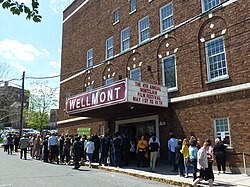 Exterior of venue (c.2015) | |
 Interactive map of Wellmont Theater | |
| Address | 5 Seymour Street Montclair, New Jersey United States |
|---|---|
| Coordinates | 40°48′45″N74°13′00″W / 40.8126°N 74.2166°W |
| Owner | The Pinnacle Companies & Greenwood Development |
| Operator | Live Nation |
| Capacity | 2,500 |
| Current use | Music Venue |
| Construction | |
| Opened | 1922 |
| Reopened | 2008 |
| Architect | Reilly & Hall |
| Website | |
| www | |
The Wellmont Theater is a theater and concert venue located in Montclair, New Jersey, United States. The theater is located on the Wellmon Arts Plaza in downtown Montclair, near the border with neighboring Glen Ridge.